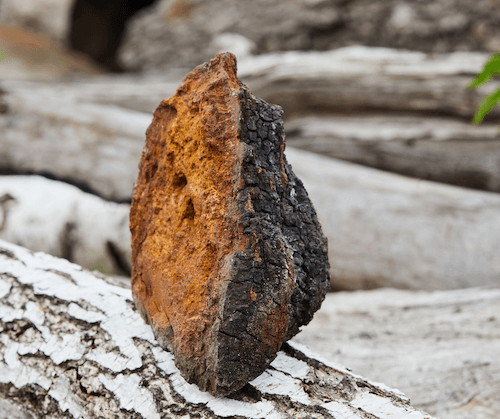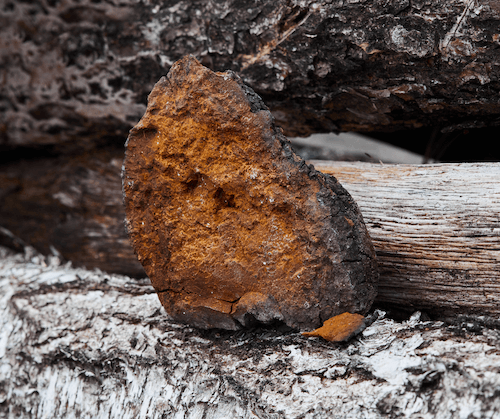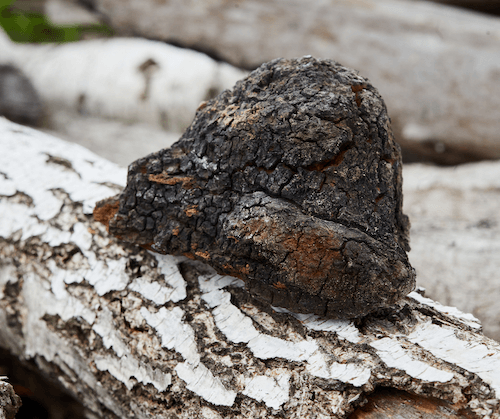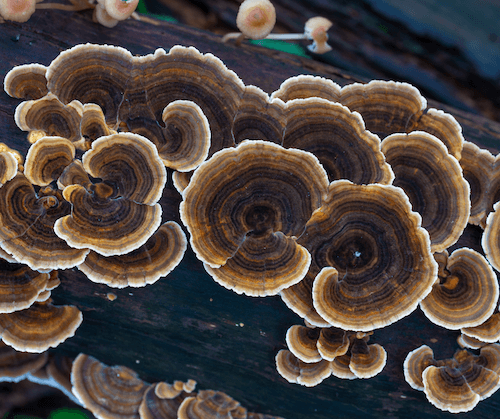Chaga. One of the most versatile and popular medicinal mushrooms. If you’re here, you’re likely thinking about incorporating chaga supplements or tea into your daily routine. But what are the potential side effects? Are there any interactions?
There really isn’t enough evidence to state what all of the potential side effects or interactions will be. And each person is unique. That’s why it’s critical to consult your physician and pharmacist before taking chaga supplements.
Chaga has gained popularity as a medicinal treatment in the Western world, but many question everything from its use cases to side effects, dosing, and traditional medicine interactions. In this article, we’ll discuss the use of chaga for medicinal purposes and share information on all of the aforementioned topics.

First, let’s cover some of the basics:
What is a chaga mushroom?
Chaga (Inonotus obliquus), one of the most popular non-hallucinogenic mushrooms, has been utilized in both traditional and folk medicine across Asia, Siberia, and many Eastern European countries for centuries.
It can be found growing on birch tree trunks and produces a nutrient-rich growth from the wood called “conk” which resembles burnt charcoal. Roughly 10-15 inches in size, the dark black exterior of chaga may be off-putting at first glance, but has a soft, orange colored inner core and is proven to contain numerous nutrients.
There's much more to explore, so let’s dive in:
What are the common side effects of taking chaga mushrooms?
While most who take chaga reap the benefits of the mushroom’s properties, there have been a few cases in which chaga was harmful to the person consuming it. In particular, drinking chaga tea, which is often used to aid the digestive system and “get things moving”, has been linked to an upset stomach at times.
The other most common and serious chaga side effects include:
- Bleeding
- Bruising
- Increased blood flow during a surgical procedure
- Aggravation of auto-immune diseases (e.g., Lupus, Arthritis, etc.)
- Low blood sugar
- Weakness
- Confusion
- Irritability
- Extreme thirst
- Kidney damage
Most of these side effects have been seen when chaga is consumed alongside specific medications. Which leads us to…
Possible interactions from chaga mushrooms
Before taking chaga, people should consult a healthcare professional if they’re taking medications for hypoglycemia, kidney disease, blood clots, and/or diabetes. Medications to be mindful of when taking chaga include, but are not limited to:
- Amaryl
- DiaBeta
- Glynase
- PresTab
- Micronase
- Actos
- Avandia
- Diabinese
- Glucotrol
- Imuran
- Simulect
- Neoral
- Sandimmune
- Zenapax
- CellCept
- Prograf
- Rapamune
- Deltasone
- Aspirin
- Plavix
- Voltaren
- Cataflam
- Ibuprofen
- Naprosyn
- Fragmin
- Lovenox
- Heparin
- Coumadin
Chaga is not suggested for those who are allergic to mushrooms or mold, breastfeeding, pregnant, or about to undergo surgery.
Chaga mushroom dosing
Chaga mushroom dosage is wholly dependent on the size, weight, and health status of an individual. Dosage recommendations vary, but most scientific studies cite using amounts of less than 5 grams over the course of a day, with some even saying to not exceed 3.6 grams.
It is recommended to start by consuming smaller amounts of chaga at first to understand personal tolerance and reduce first time usage side effects. From there, you can adjust dosage accordingly.
For more on proper dosing of chaga as a tea, check out this article.
What are the potential benefits of chaga?
Because of its unique genetic makeup, chaga is full of antioxidants and antinflammatory properties that make it a popular choice for preventative care and treatment for a variety of health needs. Rich in nutrients - including vitamin B and D, zinc, magnesium, fiber, and many more.
Chaga is often used for:
- Boosting the immune system
- Fighting inflammation
- Preventing and/or fighting cancer
- Lowering blood sugar
- Addressing high cholesterol
- Preventing or treating heart disease
- Digestive assistance and constipation
- Treating insulin imbalances
- Preventing side effects of Rx drugs
- Slowing the aging process
- Tuberculosis treatment
- Tumors
To prove chaga’s efficacy, scientists conducted an immune study on mice who were treated with an immunosuppressive alkylating agent called cyclophosphamide. It was found that, after 24 days of chaga water administration, the mice saw improvement nearly equal to immune levels seen prior to cyclophosphamide treatment.
Check out our comprehensive guide on chaga health benefits here.
The positive results suggest that chaga can be a strong immune enhancer during chemotherapy. This is just one example of numerous studies conducted on the health benefits of chaga.

How do most people take chaga mushrooms?
Today, there are dozens of ways you can enjoy chaga - but the most common ways to consume this mushroom are tinctures, extract powder, tea, or capsuled supplements.
-
Chaga tinctures (liquid extract): Consuming either a water or alcohol-base chaga extract should have positive health benefits. Dual extraction (both water and alcohol) products are arguably the best tinctures to consume. For more dual extraction products, simply add 2 milliliters of your liquid extract (e.g., half a dropper) to coffee, tea, water, or a smoothie. Please note that serving size will vary based on product.
Check out our guide on making chaga tinctures at home! -
Chaga extract (powder): People have been using chaga extract powder for thousands of years. Traditionally, people boil the chaga to make tea but it’s now commonplace to put the extract powder in a hot beverage like coffee or hot chocolate.
- Chaga tea: Chaga tea has been consumed for generations to aid with digestive health, among other health benefits. We've got an entire guide on how to make chaga tea at home, but here are the basics:
- Measure out 1 gram of chaga powder
- Boil one cup of water
- Mix and enjoy!
- Chaga extract (capsules): Last, but not least, and arguably the easiest way to consume chaga, is with capsuled supplements. The capsules contain the extract powder and can be taken as any daily supplement alongside water or your drink of choice.
A final word on chaga side effects
While there is ample evidence to suggest that chaga has positive effects on mind, body, and soul, as with anything you consume, it will affect each individual differently. It is recommended to consult a trusted healthcare professional with any questions you have about chaga before consuming it.
If you liked this article, might we suggest reading about how chaga stacks up against its mushroom cohort, reishi and cordyceps. Let us know what you think!






.png)
